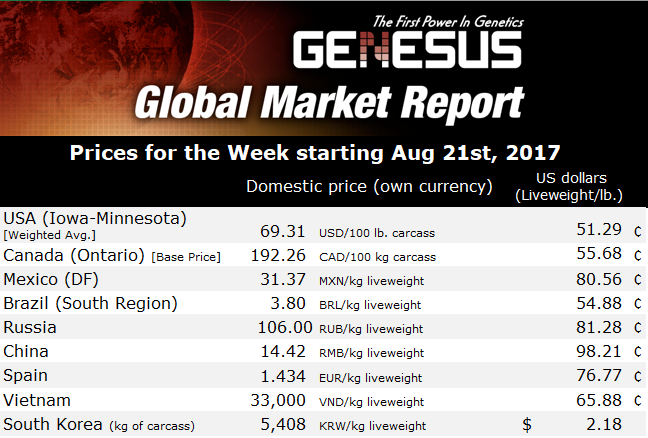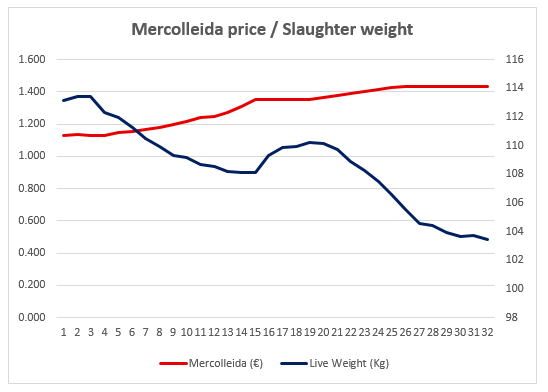
EU and Spanish Pork Markets
Mercedes Vega, General Director for Spain, Italy & Portugal
The Spanish market started January with a live weight of 113,45Kg (86.68 kg carcass weight) has been the peak this year and with a selling price of 1,129 € / kg live weight, the lowest so far this year.
The weight has been varying between 113 and 110 until the second half of May. Slaughter weights have been falling as prices began to pick up, reaching € 1,435 / kg live weight at the end of June. It has remained so far in this value.
The price / weight graph is very representative.

Right now we are in the lowest weight of this year, 103.42 kg live weight and 80.21 kg carcass (nearly 10 kg less live than in January). And the highest price of Mercolleida € 1,435 / kg live weight, away from € 1,129 of January. The summer is long and hot and does not leave a respite to the animals to regain weight.
However the price of the piglet of 56.50 € / Piglet 20 kilos Price Base Lleida, which was in May, is currently at 26.50 €. These prices are causing the producer to have to take animals to slaughterhouse even though they do not have the necessary weight because of the heat, but they need places for piglets that are coming.
We are since spring with little availability of animals (with less stock and packing plants have maintained the number slaughtered). To this has been added the tremendous heat. We have less supply than demand.
The industry has been able to pass on the price of the live animal in the pork, having its margin although this has been going down until this moment in which some continue gaining even if testimonial.
In Spain, meat has not declined its price, y it has done so in the intra-community market in this summer period. It is stabilizing in the EU. It can be sold at a good price because the cold stores remain empty throughout the EU.
Spain has again achieved another record in exports. Over 2 billion euros of turnover between meat and processed products were achieved in the first five months of 2017. According to DATACOMEX data prepared by INTERPORC (Interprofessional of the White-Coat Porcine), they have increased by 1.8% Tons exported, but the value of sales has increased by almost 20%.
China remains the first in the ranking of Spanish exports in volume 151,935 tones, accounting for 17.4% of exports with 248.5 million euros in turnover. France the second one with 135,440 tones representing 15.5% in volume, and a turnover of 360.2 million euros. Followed by Italy with 77,788 tons and 163.7 million euros in turnover, and Portugal with 46,762 tones and 132 million euros.
Which implies that China is the first destination in volume and France is the second in volume but the first one in terms of turnover.
In these exports from January to May, fresh, chilled and frozen meat represent 638,446 tones and 1,523 million euros, which is an increase of 2% and 22.6% respectively compared to the previous year. This represents 87% of export volume and 80% of external turnover of Spanish pork.
Exports in the EU in the first 5 months of the year are 1.59 million tons of porcine (-6%), with a total turnover of 3.3 billion euros, which represents an increase of +9, 7% over the previous year. Exports have been reduced in volume but have increased in turnover. China has declined in turnover by 20.6% (903 million euros), while Japan has increased by 18.5% with a turnover of 591 million euros and Korea with 345 million has increased by 78.3%. This implies that exports by the EU in the first five months of the year, more than 50% is China with 36.7%, 11.1% Japan and Korea with 9.4%.
This means that exports from the EU in the first five months of the year, more than 50%, are made to China with 36.7%, Japan with 11.1% and Korea with 9.4%.
In this year, the new extensions that are being made in the slaughterhouses are coming into operation. And this slaughtering capacity does not stay that way, the Italian group Pini lands in Spain and does so with a pig slaughterhouse in which it will invest 70 million euros. Construction begins in November and is expected to be operational by mid-2019. In the first phase, approximately 3 million pigs will be slaughtered per year, which could be increased to six million when the slaughterhouse works at full capacity.
Categorised in: Featured News, Global Markets
This post was written by Genesus



